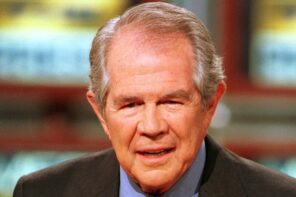One of the more unexpected developments of Donald Trump’s presidency was his metamorphosis into an evangelical hero. American Christians didn’t just like his policies, they venerated him as a near supernatural being—the last hope against Antichrist.
Such a response, to any political leader, is unusual. Historically, from the Roman Empire to contemporary America, Christians have viewed heads of state with apocalyptic hostility. The pattern began at the end of the First Century with John of Patmos’s book of Revelation, its every monster is a thinly disguised version of Nero, Domitian, or some other louche and sadistic Emperor.
John of Patmos did avoid referring to Rome directly. Whenever he named the source of worldly evil, he called it Babylon, the near mythic city whose ruins today lie outside Baghdad. Starting with the Hebrew Bible, Babylon had always served as a pliable symbol for evil. The early Babylonian king Nimrod, full of hubris, tried to build a tower to heaven, and much later the fabulously wealthy Nebuchadnezzar destroyed the Jewish Temple and held the Jews captive for 70 years.
But in Revelation, Babylon is clearly, deliberately Rome. When, for example, John sees the Whore of Babylon seated on a beast with seven heads, an angel explains that the seven heads represent seven mountains. The allegory for Rome’s seven hills is so obvious one wonders why John bothered. Perhaps because half the joy in prophecy lies in the decoding.
By the early fourth century, though, after Rome had converted to Christianity, the identification of its rulers as Antichrist became untenable. Christianity had won, so there was no longer a clear villain.
That changed in the seventh century with the advent of Islam. This new religion’s armies seemed to conquer everything in sight. From the Arabian desert they captured Jerusalem and much of the Byzantine territory right up to the walls of Constantinople. They also shattered the Persian Empire and in doing so claimed the lands of Old Babylon. Suddenly, Christian prophets didn’t need to bother with John of Patmos’s allegories. Babylon in Revelation could just be Babylon.
The Antichrist associated with this new, literal Babylon was expected to be Jewish. There’s nearly always an anti-Judaic element in Christian apocalyptic. But he could still be Muslim. (Medieval thinkers frequently viewed Judaism and Islam as one mass of circumcised unbelievers.) Antichrist would rebuild Jerusalem’s Temple and sit on a throne there. He would win adherents through miracles—fake miracles, of course. Just as Christ spoke perfect truth, Antichrist spoke only lies. Even the elect would be led into error, until finally the Archangel Michael would strike Antichrist down and bind Satan in Hell for a thousand years.
What happens next is unclear. Revelation 20:1-6 describes this period as a millennium of peace when saintly judges shall rule the earth. Evangelical tradition has largely abandoned this “millenarian” idea, favoring instead the “Rapture” model, where the elect will be taken up, just before God completely destroys the wicked and their world, probably with a nuclear bomb.
From this basic description, it’s remarkable how many of Antichrist’s boxes Trump seems to tick. Before 2016, Trump was famously irreligious. His lifestyle recalls the best stories of Roman decadence. Like Nimrod, he built a golden tower in Manhattan, itself a modern-day Babylon. As every fact-checker would attest, Trump speaks lies at a pace close to what’s expected of Antichrist—30,573, by the Washington Post’s count.
Trump’s Jewish son-in-law would normally have raised anti-Semitic apocalyptic hackles, especially because this same son-in-law owned a building whose address happens to be 666 5th Avenue (5 is a symbol of fallen humanity because of its association with bodily senses, and 666 is . . . well, you know). The recognition of Jerusalem as the capital of Israel is typically viewed as a precondition for the restoration of the Temple, again an important item on Antichrist’s resumé. And, of course, as President, Trump presided over a plague.
Yet none of these associations stuck. Trump proved to be a Teflon Antichrist. But how? His willingness to nominate conservative justices contextualizes the question but doesn’t explain the cult-like devotion he inspired.
The answer lies in prophecy and starts with Islamophobia. Because of Trump’s over-the-top anti-Muslim rhetoric, evangelicals felt they had a leader who saw what they saw—Islamic demons at Christendom’s gates. It’s no coincidence that a popular early meme from Trump’s presidency was a photoshopped image of him on a white horse, waving an American flag, and dressed as a Templar Knight, a leader of medieval Crusades against the new Babylon.
But in the latter half of Trump’s presidency, with the rise of QAnon, these associations metastasized. Supposedly a government operative, the anonymous Q acts and writes like an apocalyptic prophet—someone gifted with secret knowledge dispensed in heavily symbolic language. As with Revelation, half the joy of Q drops lies in the decoding.
Most consequentially, through Trump, Q injected millenarianism into American prophecy. According to Q, an apocalyptic storm is brewing (Trump fueled this belief in 2017 when, surrounded by generals, he spoke vaguely of “the calm before the storm”). The storm shall lead, in Q’s terms, to a Great Awakening, a phrase borrowed directly from American Protestant traditions, when evil shall be purged and just leadership established. It will be a Rapture on Earth, led by the most unlikely of heroes: Donald Trump.
The psychological gymnastics needed to maintain these beliefs are unfathomable. What perhaps they most reveal is an under-recognized truth about modern evangelicalism: whatever their spiritual bravado, American Christians do fear this world’s agents of chaos. They don’t want to live through the nightmares of the Apocalypse and have always hoped to be swept up to safety before it begins. But at the same time, they crave the Last Days. They want to see unbelievers burned on Earth and then ushered to hellfire. Ultimately whether Trump is hero or Antichrist doesn’t matter, as long as he makes these things happen.
From this perspective, Antichrist’s most terrifying characteristic contains both a promise and a threat: “Even the elect shall be led into error.”





